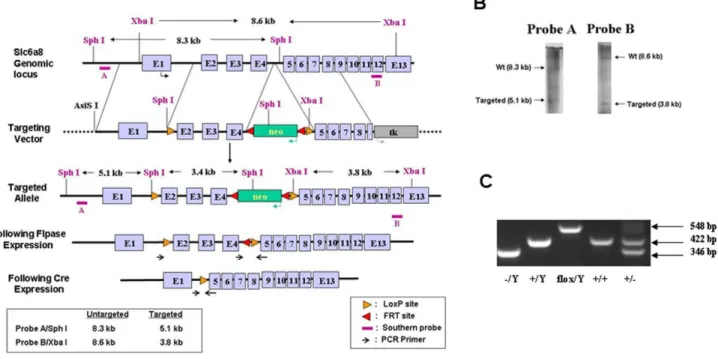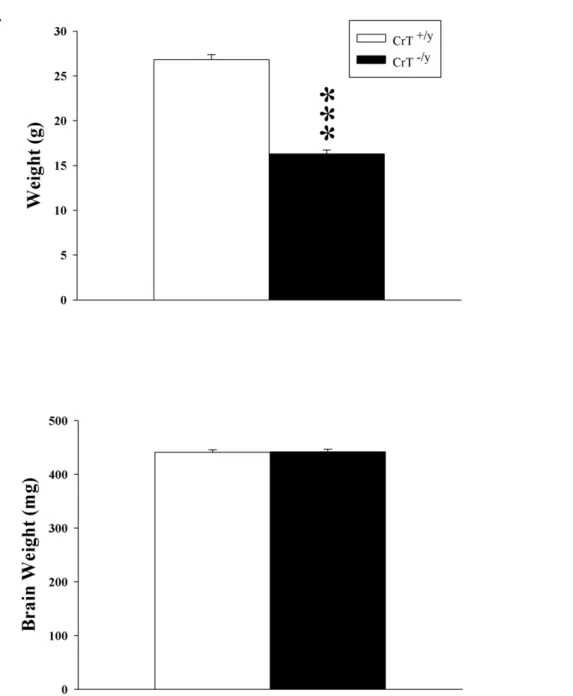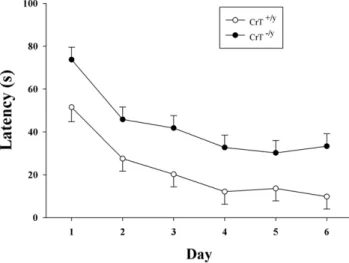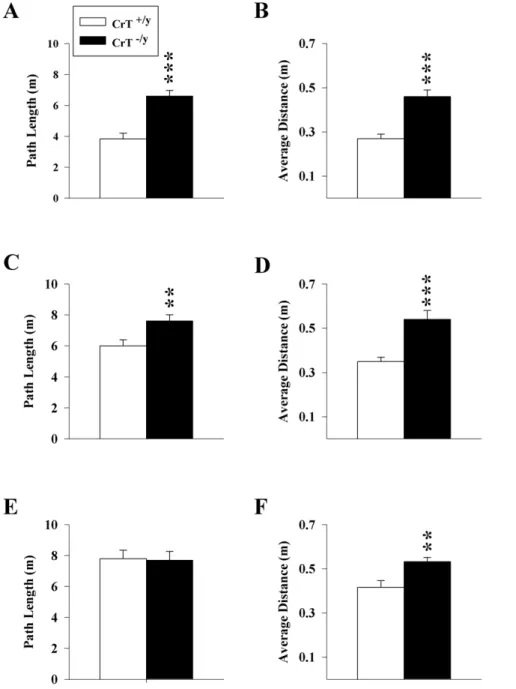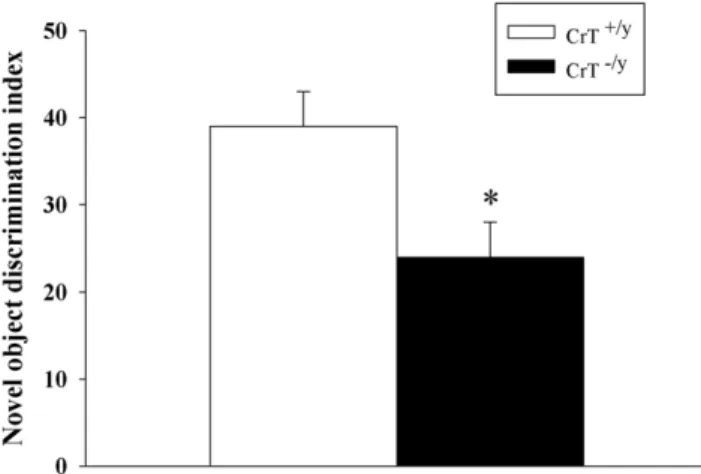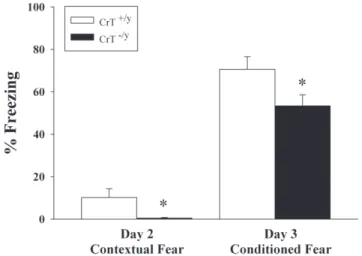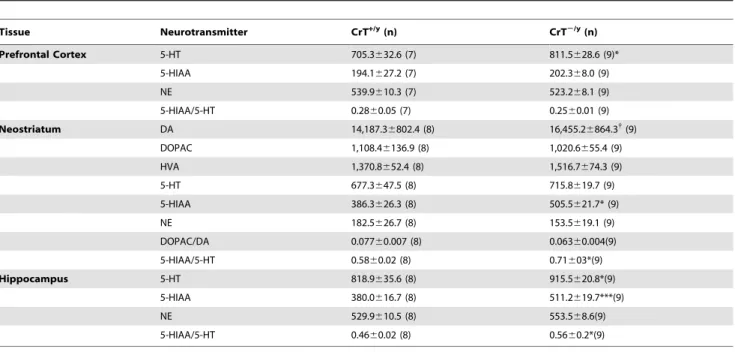Creatine Transporter (CrT; Slc6a8) Knockout Mice as a
Model of Human CrT Deficiency
Matthew R. Skelton1*., Tori L. Schaefer1
, Devon L. Graham1, Ton J. deGrauw1, Joseph F. Clark2.,
Michael T. Williams1., Charles V. Vorhees1.
1Division of Neurology, Cincinnati Children’s Research Foundation, and Department of Pediatrics, University of Cincinnati College of Medicine, Cincinnati, Ohio, United States of America,2Department of Neurology, University of Cincinnati College of Medicine, Cincinnati, Ohio, United States of America
Abstract
Mutations in the creatine (Cr) transporter (CrT;Slc6a8) gene lead to absence of brain Cr and intellectual disabilities, loss of speech, and behavioral abnormalities. To date, no mouse model of CrT deficiency exists in which to understand and develop treatments for this condition. The purpose of this study was to generate a mouse model of human CrT deficiency. We created mice with exons 2–4 ofSlc6a8flanked by loxP sites and crossed these to Cre:CMV mice to create a line of ubiquitous CrT knockout expressing mice. Mice were tested for learning and memory deficits and assayed for Cr and neurotransmitter levels. Male CrT2/y(affected) mice lack Cr in the brain and muscle with significant reductions of Cr in other tissues including
heart and testes. CrT2/ymice showed increased path length during acquisition and reversal learning in the Morris water
maze. During probe trials, CrT2/ymice showed increased average distance from the platform site. CrT2/y mice showed
reduced novel object recognition and conditioned fear memory compared to CrT+/y. CrT2/ymice had increased serotonin
and 5-hydroxyindole acetic acid in the hippocampus and prefrontal cortex. Ubiquitous CrT knockout mice have learning and memory deficits resembling human CrT deficiency and this model should be useful in understanding this disorder.
Citation:Skelton MR, Schaefer TL, Graham DL, deGrauw TJ, Clark JF, et al. (2011) Creatine Transporter (CrT; Slc6a8) Knockout Mice as a Model of Human CrT Deficiency. PLoS ONE 6(1): e16187. doi:10.1371/journal.pone.0016187
Editor:Efthimios M. C. Skoulakis, Biomedical Sciences Research Centre ’Alexander Fleming’, Greece
ReceivedSeptember 2, 2010;AcceptedDecember 9, 2010;PublishedJanuary 13, 2011
Copyright:ß2011 Skelton et al. This is an open-access article distributed under the terms of the Creative Commons Attribution License, which permits unrestricted use, distribution, and reproduction in any medium, provided the original author and source are credited.
Funding:This work was supported by National Institutes of Health (NIH) grants DA021394 (CVV), ES015689 (MTW), T32 ES007051 (TLS & DLG), and NS049172 (JFC) and the Division of Neurology at CCHMC. The funders had no role in study design, data collection and analysis, decision to publish, or preparation of the manuscript.
Competing Interests:The authors have declared that no competing interests exist.
* E-mail: Matthew.skelton@cchmc.org
.These authors contributed equally to this work.
Introduction
The creatine (Cr) transporter (CrT;SLC6a8) is a member of the solute carrier 6 family that transports Cr into cells in a Na+, K+
-dependent manner where it is used as a readily available phosphate pool to replenish ATP levels [1]. As the CrT is located on the X-chromosome [2], mutations in the CrT show X-linked inheritance [3,4]. Males carrying deletions in the CrT show moderate to severe intellectual disability with significant speech delay or lack of speech [3–11]. In addition, CrT deficient patients have increased rates of epilepsy [7]. Patients have increased urinary Cr/creatinine ratios and no brain Cr peak when examined by magnetic resonance spectroscopy (MRS) [3]. Cultured fibroblasts from these patients show Cr uptake only at high levels (.500 nM) unless transfected with a functional CrT [12]. Supplementation with Cr or the synthesis precursor arginine does not increase Cr in brain or improve quality of life of affected patients [6,13]. CrT deficiency is a relatively newly recognized disorder and is not routinely screened which makes estimates of the prevalence difficult to determine. Initial estimates are that it represents ,2% of all X-linked mental retardation of unknown etiology [14–16].
CrT expression is highest in kidney, heart, skeletal muscle, and brain [1]. In the adult rat CNS, CrT expression has been localized to oligodendrocytes and brain capillary endothelial cells [17–19], which is the likely route of entry for Cr into the brain [20]. In the
mouse brain, CrT has been observed as early as embryonic day 13 [17,19] and postnatal expression is observed in the hippocampus, neocortex, and basal ganglia [18]. Immunohistochemical studies show high expression of CrT in the rat brain, particularly in the CA3 and dentate gyrus regions of the hippocampus [21].
In order to investigate CrT deficiency, we generated a transgenic mouse with a portion of the CrT gene flanked by loxP sites. This mouse was used to create ubiquitous CrT knockout mice mimicking affected patients. Ubiquitous CrT knockout mice were tested in a variety of tasks, with particular emphasis on tests of learning and memory. The results show that this model reflects many of the features of human CrT deficiency.
Methods
Generation of CrT knockout mice
Cre recombinase driven by the CMV promoter (B6.C-Tg(CMV-cre)1Cgn/J; Jackson Laboratory, Bar Harbor, ME) was utilized to create ubiquitous CrT knockout mice. The Cre and Flp were subsequently removed via breeding. As the CrT is X-linked only males have a single copy of the CrT gene therefore WT male mice are referred to as CrT+/y
and knockout mice as CrT2/y
. Genotyping was performed using a touchdown PCR protocol: 1) 95uC-5 min; 2) 2 cycles: 95uC-30 s, 60uC-30 s and 72uC-1 min; 3) 20 cycles: 95uC-30 s, 60uC-30 sD-0.5uC each cycle, 72uC-1 min; 4) 10 cycles: 95uC-30 s, 50uC-30 s and 72uC-1 min 5) 72uC-10 min. Primers (designated on Figure 1A) used were AGGTCCAGACAGTAACTACCCTTC,
TGGGTTTGCAGCTTGGTGTTATTGC and
TCCTACAC-CAATACCCCCATAAGC. The product sizes are as follows: CrTflox: 548 bp; CrT+: 422; CrT2: 346 bp (Figure 1C). The vivarium is fully accredited by the AAALAC and all protocols were approved by the Institutional Animal Care and Use Committee (Protocol#8C08066).
Behavioral Testing
Sixteen adult males (postnatal day 90–110 at beginning of testing) of each genotype were used in the behavioral experiment. Litters were only represented once per genotype. As CrT deficiency is X-linked only males are consistently affected, therefore only the male mice were tested. Mice were weighed once prior to testing. The testing order consisted of: locomotor behavior (1 day duration), Morris water maze (MWM) cued (6 days) and hidden platform phases (21 days), novel object recognition (5 days), sociability (1 day), acoustic startle (1 day), and conditioned fear (3 day). Mice were tested in one task at a time with the next starting 1 day after the completion of the previous task for a total of 38 days of testing. In order to minimize circadian effects, animals were tested during the same time interval each day (1200–1600 h).
Locomotor behavior
The task assesses exploration and general locomotor activity [24]. Animals were tested in an automated activity monitor (Accuscan Electronics, Columbus, OH) as described previously [25–27] for 1 h. Locomotor chambers were 41 cm2with 16 LED-photodector
beams across each side of the chamber in the X and Y-planes (mounted 2 cm above the floor) and another row to detect vertical movements positioned 8 cm above the floor. Photocells were spaced 2.5 cm apart. Animals were placed in the chamber for 1 h and allowed to explore. Dependent measures for locomotor are measured in number of times the beam is broken.
Morris water maze
The MWM is a test of spatial learning and reference memory [28]; animals were tested as described previously [25,27]. Prior to hidden platform testing, visible platform training (cued learning) was conducted for 6 days. During this phase, curtains were closed around the maze to obscure prominent distal cues and a 10 cm diameter platform with an orange ball mounted above it on a brass rod was placed in a predetermined quadrant. On the first day, 6 trials (90 s) were administered with the platform and start in the same position; 2 trials per day were given on subsequent days with the start and platform positions randomized.
The hidden platform portion was conducted in three phases (6 days/phase: acquisition, reversal, and shift) consisting of 4 trials per day for 6 days for animals to learn the location of the hidden platform followed by a single probe trial (no platform) on day 7 [28]. Platform diameters were 10 cm for acquisition, 7 cm for reversal (located in the opposite quadrant), and 5 cm for shift, (located in one of the adjacent quadrants). Performance was measured using AnyMaze software (Stoelting Company, Wood Dale, IL).
Figure 1. Generation of the CrTflox/floxmice.(A) Schematic of mouse Slc6a8 locus (top), targeting vector (middle), and targeted locus (bottom). Exons 2-4 were flanked by LoxP sites and the neomyocin cassette was flanked by FRT sites. Neo cassette was excised prior to breeding to any Cre recombinase expressing mice. (B) Southern blot showing successful recombination in ES cells used for generation of the CrTfloxmice. (C) PCR
products are shown for the respective genotypes. Due to the CrT being located on the X-chromosome, males have one copy of the CrT gene and are designated as2/y (left),+/y (center-left) or flox/y (center) while females (center right and right) have two copies of the CrT. Female2/2mice are not generated as there are no CrT deficient females.
Novel Object Recognition
Novel object recognition (NOR) is a test of short-term memory [29]. Mice were habituated to the arena (91 cm diameter) for 2 days (10 min/day) followed by 2 days (10 min/day) of habituation to two identical objects. On the test day, animals were presented with two new identical objects until 30 s of cumulative observation time was obtained. One h later memory was tested by presenting the animal with an identical copy of one of the familiar objects along with a novel object. A discrimination index was calculated by subtracting the time observing the familiar object from time spent observing the novel object.
Sociability
Mice were tested for social preference as described by Crawley et al. [30]. The test arena (40640 cm) was made of clear acrylic with three chambers (outer chambers: 17640 cm; inner chamber
Figure 2. Body weight is reduced in CrT2/ymice while brain weights were unchanged.(A) Body weights were collected prior to behavioral
testing and (B) brain weights were collected from animals following the end of behavioral testing. Data are presented as Mean6SEM. *** P,0.001, n = 16/genotype. doi:10.1371/journal.pone.0016187.g002
Table 1. Cr levels (Mean6SEM) in CrT+/yand CrT2/ymice
(n = 8/tissue).
Tissue (nM/mg tissue) CrT+/y CrT2/y
Brain 18,11662378 BDL
Muscle 21,8236531 BDL
Heart 50,01265345 11,01261612***
Testes 24,7316684 22,0196922*
Kidney 10,82462346 9,73161151
Serum (nM/mL) 275632 12368***
*P,0.05;
***P,0.001 vs. Control. BDL = below detection limit. doi:10.1371/journal.pone.0016187.t001
5640 cm; with 568 cm openings between chambers). A confine-ment cage for a conspecific of the same-sex (7 cm i.d., stainless steel rods spaced 1 cm apart) was placed in each outer chamber. Testing (habituation, social preference, and social novelty) was initiated by placing the test animal in the center compartment and leaving them undisturbed for 10 min. Following habituation, social interaction was tested by placing a mouse in one of the side compartment cages. Social novelty was tested by placing a second mouse in the confinement cage in the opposite compartment. Data were collected using AnyMaze Software (Stoelting Company). Time in each zone was recorded.
Acoustic startle response
Acoustic startle combined with prepulse inhibition (PPI) was used as a test of sensory gating [31]. Responses to an acoustic startle stimulus were measured in an SR Lab apparatus from San Diego Instruments (San Diego, CA) with a 70 dB background white noise. Following a 5 min acclimation period, 4 trial types (5 trials each) were administered in a Latin square design over 7 min: 1) no stimulus; 2) stimulus alone (120 db SPL white noise burst) and prepulses at 3) 70 dB and 4) 76 dB. Startle responses were recorded for 100 ms following stimulus onset, prepulses preceded the startle stimulus by 70 ms (onset to onset), and stimuli lasted for 20 ms. Maximum startle amplitude (Vmax) was recorded in units of
voltage change (mV).
Conditioned fear/Conditioned fear extinction
Cued and contextual fear were assessed as described previously with modification [32]. On day 1, mice were exposed to 30 tones (82 dB, 2 kHz, 30 s on/off cycle) followed by 3 tone-footshock pairings (0.5 mA for 1 s). On the following day, animals were returned to the chamber with no tone or shock presented as a test of contextual fear. The next day, animals were placed in the chamber with a novel grid floor. Following 3 min acclimatization, the tone was presented and freezing behavior scored. Animals were then exposed to 30 cycles of 30 s with and 30 s without tone to measure fear extinction. Freezeframe software and Coulbourn test chambers were used (Coulbourn Instruments, Allentown, PA). Percent time freezing was analyzed.
Creatine determination
A group of animals not behaviorally tested was assayed for tissue and serum Cr levels using a colorimetric Cr assay (Cr Assay Kit, Caymen Chemical, Ann Arbor, MI). Cr levels were normalized to tissue weight or serum volume. For CNS tissue, whole brain was used.
Neurotransmitter Assessment
A subset of animals was euthanized following behavioral testing and the prefrontal cortex (PFC), hippocampus, and neostriatum were assayed for serotonin (5-HT), dopamine (DA), their metabolites, and norepinephrine (NE) using HPLC-ECD as described previously [33].
Statistical Analysis
Data were analyzed using general linear model analysis of variance (ANOVA) (Proc GLM; SAS Institute, Cary, NC). For data with a repeated measure factor, data were analyzed using
mixed models (Proc Mixed) with Kenward-Rodger degrees of freedom that can be fractional. Covariance structures were checked for best fit and the autoregressive (AR(1)) covariance structure used. Significant (P,0.05) interactions were analyzed using slice-effect ANOVAs at each level of the repeated measure factor. Data are presented as means6standard error of the mean (SEM) or as least square (LS) Mean+LS SEM.
Results
Body Weight
In order to determine the effects of the deletion of CrT on body and brain weights, animals were weighed prior to testing and brains were weighed after behavioral testing. CrT2/y
mice showed reduced body weights compared to CrT+/y
mice (F(1,30) = 205.3, P,0.001; Figure 2A). Brain weight was not altered (Figure 2B).
Creatine Levels
CrT deficient patients show no Cr in the brain as determined by MRS [3]. In order to determine the effectiveness of the CrT2/y model, Cr levels were measured by colorimetric assay in various tissues. In brain and muscle, Cr levels were below detection limits in CrT2/y mice (Table 1). Reductions of Cr were observed in the heart (F(1,15) = 48.40, P,0.001), serum (F(1,15) = 20.08, P,0.001), and testes (F(1,15) = 5.57, P,0.05) of CrT2/y mice compared with CrT+/y
mice, with no difference in kidneys. This suggests that CrT2/ymice have a similar biochemical phenotype compared to CrT deficient patients.
Locomotor Activity
Locomotor activity was assessed in order to determine general activity levels and to determine if reduced Cr levels in muscle affected normal locomotion in CrT2/y
mice. CrT2/y
mice showed
Figure 3. Initial hypoactivity and increased peripheral actvity in CrT2/y mice. Locomotor activity was measured for 1 h in a novel
environment. Top panel represents total activity; bottom panel is activity in the periphery of the locomotor chamber. The inset in the bottom panel represents the main effect of gene. Data are presented as LSMeans6SEM. *P,0.05, n = 16/genotype.
doi:10.1371/journal.pone.0016187.g003
Figure 4. CrT2/ymice show deficits during the visible platform
phase of the MWM.The visible platform phase consisted of 6 trials on day 1 followed by 2 trials/day for 5 days. While the latencies were longer in CrT2/y
mice for each day compared with CrT+/y
mice the percent improvement across days was similar between the genotypes. Data are presented as LSMeans6SEM. n = 16/genotype.
doi:10.1371/journal.pone.0016187.g004
decreased horizontal activity during the first 5 min [genotype X interval (F(11,320) = 2.30, P,0.01; Figure 3, top)], however they were more active in the periphery compared with CrT+/y
mice after the first interval [genotype (F(1,57.1) = 4.53, P,0.05, Figure 3, bottom)]. No effect of genotype was observed for center region exploration. There were no differences observed in vertical movements (rearing) between CrT+/y
and CrT2/y
mice.
Morris Water Maze-Visible Platform
As CrT deficient patients show global intellectual deficits, CrT2/y mice were tested in several learning tasks. Visible platform testing in the MWM was used to determine if CrT2/y
mice had sensorimotor or motivational deficits in escaping the maze. CrT2/ymice had a longer latency to find the platform compared with CrT+/y
mice [genotype (F(1,45.7) = 21.23, P,0.001; Figure 4)]. As animals
showed an effect of swim speed during hidden platform trials, percent change during the visible phase for each day after day-1 was calculated. No difference between CrT2/y and CrT+/y
mice was observed using this index of improvement across days (Mean6SEM improvement: 4069% CrT+/y
vs 47610% CrT2/y) indicating that CrT2/ymice had similar performance improvement compared to WT controls. The similar improvement observed between CrT2/y
and CrT+/y
mice suggests that motivation and vision were intact in the CrT2/ymice and the difference observed is the result of reduced swim speed in the CrT deficient mice.
Morris Water Maze-Hidden Platform
The hidden platform test of the MWM was used to assess spatial learning and reference memory. Three phases of the test were performed: acquisition (initial learning), reversal (platform in the
Figure 5. CrT2/ymice have spatial learning and memory deficits.Path length for the (A) Acquisition, (C) Reversal, and (E) Shift phases of the
MWM; each phase consisted of 4 (90 s) trials/day for 6 consecutive days. Probe trials of 30 s with the platform removed were conducted on the 7th
opposite quadrant from acquisition), and shift, (platform in a quadrant adjacent to where it was during reversal) and with platform size reduced for each phase after acquisition in order to make the task progressively more difficult. As there was a main effect of genotype on swim speed (all P,0.001) in all phases of the hidden platform, path length was analyzed because it is independent of swim speed.
Acquisition. CrT2/y mice had longer path lengths
comp-ared with CrT+/y
mice [genotype (F(1,51.4) = 28.72, P,0.001, Figure 5A)]. For the probe trial, CrT2/y
mice had a greater average distance from the platform [genotype (F(1,30) = 24.4, P,0.001, Figure 5B)] and a lower percent distance travelled in the target quadrant compared with CrT+/y
mice (F(1,30) = 24.74, P,0.001; LS Means6SEM: CrT+/y
: 47.163.8%, CrT2/y: 25.063.3%).
Reversal. CrT2/y
mice had longer paths to the platform than CrT+/y
mice [genotype (F(1,47.3) = 7.68, P,0.01, Figure 5C)]. For the probe trial, CrT2/ymice had a greater average distance
from the platform [genotype (F(1,30) = 17.8; P,0.001, Figure 5D)] and a lower percent distance travelled in the target quadrant compared with CrT+/y
mice (F(1,30) = 16.25, P,0.001; LS Means
6SEM: CrT+/y
: 40.562.8%; CrT2/y
: 19.864.3%).
Shift. No main effect of genotype was observed during the shift phase of testing (Figure 5E). CrT2/y
mice had shorter path lengths on day 1 of shift compared with CrT+/y
mice [genotype X day interaction (F(5,115) = 3.34; P,0.01)]. For the probe trial, CrT2/y mice had a greater average distance from the platform [genotype (F(1,30) = 8.59, P,0.01; Figure 5F)] and a lower percent distance travelled in the target quadrant compared with CrT+/y
mice (F(1,30) = 5.84 P,0.05; LS Means6SEM: CrT+/y
: 38.565.0% vs. CrT2/y
: 24.862.7%). The data from the shift phase indicate that neither the CrT+/y
or CrT2/y
mice were able to learn well under these more demanding conditions and the lack of difference between genotypes appears to be caused by this final phase being excessively difficult. This can be seen by comparing the path length of CrT+/y
mice across phases. It is evident that both genotypes showed reduced performance with each subsequent phase until during the third phase even CrT+/y
controls showed poor learning.
Novel Object Recognition
NOR is a test of short-term, hippocampally-dependent memory. CrT2/y mice spent less time attending to the novel object than CrT+/y
mice [genotype (F(1,30) = 7.30, P,0.05, Figure 6)]. CrT2/y
mice investigated the objects and reached the 30 s criterion, therefore, the visual system of CrT2/ymice are sufficiently intact that they can see and recognize the objects adequately to respond to them appropriately.
Acoustic Startle Response with Prepulse Inhibition The measurement of acoustic startle requires the animal to deflect the platform on which the holding cylinder is mounted against a load cell mounted underneath, therefore, body mass is a factor in the measurement of the amplitude of the response. In order to adjust for the reduced body mass of the CrT2/y mice, body weight was used as a covariate in the analysis. There were no differences in acoustic startle response with or without prepulse inhibition using weight as a covariate (Figure 7).
Sociability
As CrT deficient patients have been reported to have some autistic-like features, CrT2/y
mice were tested for social preference for conspecifics. No differences were observed in initial social preference for a conspecific stranger mouse (Figure 8A) or a second stranger mouse located in a different part of the apparatus during the second or novelty phase of the test (Figure 8B). CrT+/y
and CrT2/ymice showed equivalent preference for stranger mice during both phases.
Conditioned fear and extinction
CrT2/y mice were tested for emotional memory using a conditioned fear paradigm. CrT2/y
mice spent less time freezing than CrT+/y
mice in response to conditioning (contextual fear) on day-2 [genotype (F(1,23) = 1.78, P,0.05, Figure 9)]. CrT2/ymice spent less time freezing in response to tone (cued fear) on day 3 than CrT+/y
mice [genotype (F(1,24) = 4.71, P,0.05, Figure 9)]. No differences were observed in the rate of cued fear extinction.
Neurotransmitters
In order to characterize general brain systems, monoamine neurotransmitter levels were assessed in brain regions of CrT+/y
Figure 6. CrT2/y mice show deficits in object recognition
memory. The novel object recognition test was conducted 1 h
following familiarization. The novel object discrimination index was determined by subtracting the percent time with the familiar object from the percent time with the novel object. Data are Mean6SEM. *P,0.05, n = 16/genotype.
doi:10.1371/journal.pone.0016187.g006
Figure 7. Acoustic Startle with prepulse inhibition. Startle
response was measured following exposure to a 120 dB tone. For prepulse (PP) inhibition, tone was preceded by a softer tone of either 70 or 76 dB. As the size of the animal affects the ability to move the chamber, weight was used a covariate in the analysis of startle response. No differences were noted in startle response with weight as a covariate. Data are Mean6SEM; n = 16/genotype.
doi:10.1371/journal.pone.0016187.g007
and CrT2/y
mice. In the PFC, 5-HT levels were increased in CrT2/y
mice (F(1,14) = 6.0, P,0.05; Table 2) compared with CrT+/y
mice.
In the hippocampus, 5-HT (F(1,16) = 5.81, P,0.05), 5-hydro-xyindoleacetic acid (5-HIAA) (F(1,16) = 25.5, P,0.001), and the 5-HIAA/5-HT ratio (F(1,16) = 7.48, P,0.05) were increased in CrT2/y mice compared with CrT+/y
mice. NE levels were unchanged.
In the neostriatum, CrT2/y
mice showed a trend towards increased DA (F(1,16) = 3.64, P,0.10); they had increased levels of 5-HIAA (F(1,16) = 12.41, P,0.01) and 5-HIAA/5-HT (F(1,16) = 11.63, P,0.01) compared with CrT+/y
mice. No changes were observed for 5-HT, DOPAC, DOPAC/DA, HVA, or NE in the neostriatum.
Discussion
In humans, loss of function of the CrT leads to intellectual impairment, loss of language, and autistic-like behavioral abnor-malities, and no treatment is available [3,4,6,7,9,10,13]. In order to model this disorder and also understand the role of Cr in the brain, we created CrT2/ymice. The lack of Cr in many tissues of the CrT2/y mice shows that the recombination resulted in a successful disruption of the CrT gene.
Human CrT deficient patients show no brain Cr using MRS [3]. Similarly, Cr is absent in the brain of CrT2/y
mice. The results of this study suggest that the mouse brain is unable to synthesize Cr despite having the requisite mechanisms [19,34]. In addition, CrT2/ymice show Cr reductions in muscle, which is in contrast with case reports of two CrT deficient patients who had either the presence of Cr [6] (although levels were not determined) or normal Cr levels in muscle [35]. It is possible that these patients had a mutation that allowed for the expression of a CrT splice variant, and this is supported by mutation analysis of these patients that showed the mutations occurred outside of the known splice variants for the CrT [36,37]. Additional studies in human CrT patients using MRS could provide useful information on the relationship between the mutations in the CrT and the presence of Cr in muscle. The only tissue in which Cr levels appear to be normal was in kidney, which could be due to the role of the kidney in Cr synthesis or elimination. It is likely that the reductions in serum Cr levels are due to the lack of absorption of Cr from the gut since the CrT is expressed in the small intestine [38], which is the hypothesized route of Cr absorption from the diet.
Similar to human CrT patients, CrT2/y
mice show cognitive impairments across a variety of learning and memory tests. CrT2/y mice show spatial learning and memory deficits during the first two phases of the MWM. While the CrT2/y
mice were slower swimmers than CrT+/y
mice, swim speed does not affect path length; therefore this measure is not confounded by performance effects. CrT2/y mice showed no deficit during the shift phase of the MWM; however, this was because even the CrT+/y
control mice could not learn this phase adequately, precluding the detection of differences between genotypes. Nonetheless, on probe trials during this third phase, the CrT2/y
mice were impaired, therefore, even the little they were able to learn during this phase they could not remember as well as CrT+/y
.
Figure 8. Social preference test.Mice were allowed to investigate a conspecific (A) inside a holding cage on one side of the apparatus versus an empty holding cage on the opposite side. Immediately afterward they were tested for social novelty (B) with a second conspecific placed in the holding cage on the opposite side from the original mouse. Mice were given 10 min to explore the arena during each test. Data are Mean6SEM; n = 16/genotype.
doi:10.1371/journal.pone.0016187.g008
Figure 9. CrT2/ymice have reduced contextual and emotional
memory compared with CrT+/ymice.Mice were exposed to
tone-shock pairings on day 1 of the conditioned fear test. On day 2 (contextual) they were tested for freezing in the same environment with no tone for 6 min. On the third day (conditioned), the floor was replaced with a novel floor. After 3 min of habituation, mice were exposed to the tone for 3 min and freezing measured. Data are presented as Mean6SEM. *P,0.05; n = 11 CrT+/ymice, n = 13 CrT2/y
mice.
It is conceivable that sensory deficits play a role in the learning and memory deficits. For example, CrT is highly expressed in the retina [39], which could lead to visual problems in CrT2/y mice. The improvement in the cued version of the MWM as well as the animals’ readily observing and responding to objects during the NOR task (no animal failed to accumulate the 30 s observation criterion) suggests that the visual system is not disrupted in the CrT2/y
mice sufficiently to impair visually-mediated tests. In addition, the CrT2/y
mice acquired the platform’s location as shown by CrT2/ymice having an average latency of 46 s out of a 90 s trial during the acquisition phase, suggesting that distal visual cues were used by the CrT deleted mice to navigate to the platform. This suggests that neither sensorimotor nor motivational impairments contributed to the observed deficits.
During the probe trials, CrT2/y
mice showed impaired reference memory compared with CrT+/y
mice. In addition to the probe trials, mice were assessed for memory in the NOR and conditioned fear tests. CrT2/y
mice showed reduced memory in both of these tasks. The deficits in memory across tasks combined with the learning trials in the MWM suggest that CrT2/y mice have a general cognitive impairment. In humans, the type of learning deficit has not been characterized in detail because the phenotype prevents systematic assessment (Byars, personal communication).
There appears to be a disruption of the serotonergic system in CrT2/y
mice as evidenced by increases in 5-HT in hippocampus and prefrontal cortex along with increased 5-HT turnover in the neostriatum and hippocampus. It has been shown that serotonergic drugs such as fluoxetine and paroxetine increase Cr kinase activity [40,41], suggesting a relationship between 5-HT and Cr. Addition-ally, exposure to 5-HT, the 5-HT1A receptor agonist
8-hydroxy-N,N-dipropyl-2-aminotetralin, or fluoxetine increases the speed of anterograde mitochondrial transport in hippocampal neurons, while serotonergic antagonism slows mitochondrial transport [42]. Further, there have been recent reports suggesting that 5-HT may play a role in mitochondrial activity, as 5-HT receptor agonists increase ATP and ATP synthaseblevels as well as increase basal cellular respiration in kidney cells [43]. It is possible that the neurons of the PFC and hippocampus increased 5-HT activity in response to a reduction in cellular energy sources. As increases in 5-HT have been shown to alter neuronal structure and behavior [44,45], it is possible that the 5-HT changes are involved in the behavioral effects, including anxiety. CrT2/y
mice spend more time in the periphery of the locomotor chamber with no change in central time; since central movement reflects anxiety, the data suggest that anxiety is not altered in these mice. Additional tests of anxiety will be required to address this in greater depth, including testing for a relationship between these behaviors and changes in 5-HT.
In sum, the CrT2/y mouse provides a tool for studying the relationship between Cr and 5-HT. More broadly, CrT2/ymice exhibit cognitive deficits similar to those seen in CrT deficient patients and as such provides a model with good fidelity to the human condition suitable to test potential therapies for this currently untreatable disorder.
Author Contributions
Conceived and designed the experiments: MRS TJD JFC MTW CVV. Performed the experiments: MRS TLS DLG. Analyzed the data: MRS. Wrote the paper: MRS.
References
1. Wyss M, Kaddurah-Daouk R (2000) Creatine and creatinine metabolism. Physiol Rev 80: 1107–1213.
2. Gregor P, Nash SR, Caron MG, Seldin MF, Warren ST (1995) Assignment of the creatine transporter gene (SLC6A8) to human chromosome Xq28 telomeric to G6PD. Genomics 25: 332–333.
3. Cecil KM, Salomons GS, Ball WS, Jr., Wong B, Chuck G, et al. (2001) Irreversible brain creatine deficiency with elevated serum and urine creatine: a creatine transporter defect? Ann Neurol 49: 401–404.
4. DeGrauw TJ, Salomons GS, Cecil KM, Chuck G, Newmeyer A, et al. (2002) Congenital creatine transporter deficiency. Neuropediatrics 33: 232–238. Table 2.Neurotransmitter levels (Mean6SEM pg/mg tissue) and turnover ratios in CrT+/yand CrT2/ymice.
Tissue Neurotransmitter CrT+/y(n) CrT2/y(n)
Prefrontal Cortex 5-HT 705.3632.6 (7) 811.5628.6 (9)*
5-HIAA 194.1627.2 (7) 202.368.0 (9)
NE 539.9610.3 (7) 523.268.1 (9)
5-HIAA/5-HT 0.2860.05 (7) 0.2560.01 (9)
Neostriatum DA 14,187.36802.4 (8) 16,455.26864.3{
(9)
DOPAC 1,108.46136.9 (8) 1,020.6655.4 (9)
HVA 1,370.8652.4 (8) 1,516.7674.3 (9)
5-HT 677.3647.5 (8) 715.8619.7 (9)
5-HIAA 386.3626.3 (8) 505.5621.7* (9)
NE 182.5626.7 (8) 153.5619.1 (9)
DOPAC/DA 0.07760.007 (8) 0.06360.004(9)
5-HIAA/5-HT 0.5860.02 (8) 0.71603*(9)
Hippocampus 5-HT 818.9635.6 (8) 915.5620.8*(9)
5-HIAA 380.0616.7 (8) 511.2619.7***(9)
NE 529.9610.5 (8) 553.568.6(9)
5-HIAA/5-HT 0.4660.02 (8) 0.5660.2*(9)
*P,0.05, ***P,0.001, {
P,0.10 vs. CrT+/y.
doi:10.1371/journal.pone.0016187.t002
5. Anselm IA, Alkuraya FS, Salomons GS, Jakobs C, Fulton AB, et al. (2006) X-linked creatine transporter defect: a report on two unrelated boys with a severe clinical phenotype. J Inherit Metab Dis 29: 214–219.
6. DeGrauw TJ, Cecil KM, Byars AW, Salomons GS, Ball WS, et al. (2003) The clinical syndrome of creatine transporter deficiency. Mol Cell Biochem 244: 45–48.
7. Mancardi MM, Caruso U, Schiaffino MC, Baglietto MG, Rossi A, et al. (2007) Severe epilepsy in X-linked creatine transporter defect (CRTR-D). Epilepsia 48: 1211–1213.
8. Poo-Arguelles P, Arias A, Vilaseca MA, Ribes A, Artuch R, et al. (2006) X-Linked creatine transporter deficiency in two patients with severe mental retardation and autism. J Inherit Metab Dis 29: 220–223.
9. Salomons GS, van Dooren SJ, Verhoeven NM, Cecil KM, Ball WS, et al. (2001) X-linked creatine-transporter gene (SLC6A8) defect: a new creatine-deficiency syndrome. Am J Hum Genet 68: 1497–1500.
10. Salomons GS, van Dooren SJ, Verhoeven NM, Marsden D, Schwartz C, et al. (2003) X-linked creatine transporter defect: an overview. J Inherit Metab Dis 26: 309–318.
11. Sempere A, Fons C, Arias A, Rodriguez-Pombo P, Colomer R, et al. (2009) Creatine transporter deficiency in two adult patients with static encephalopathy. J Inherit Metab Dis.
12. Rosenberg EH, Munoz CM, DeGrauw TJ, Jakobs C, Salomons GS (2006) Overexpression of wild-type creatine transporter (SLC6A8) restores creatine uptake in primary SLC6A8-deficient fibroblasts. J Inherit Metab Dis 29: 345–346.
13. Fons C, Sempere A, Arias A, Lopez-Sala A, Poo P, et al. (2008) Arginine supplementation in four patients with X-linked creatine transporter defect. J Inherit Metab Dis 31: 724–728.
14. Lion-Francois L, Cheillan D, Pitelet G, Acquaviva-Bourdain C, Bussy G, et al. (2006) High frequency of creatine deficiency syndromes in patients with unexplained mental retardation. Neurology 67: 1713–1714.
15. Puusepp H, Kall K, Salomons GS, Talvik I, Mannamaa M, et al. (2009) The screening of SLC6A8 deficiency among Estonian families with X-linked mental retardation. J Inherit Metab Dis.
16. Clark AJ, Rosenberg EH, Almeida LS, Wood TC, Jakobs C, et al. (2006) X-linked creatine transporter (SLC6A8) mutations in about 1% of males with mental retardation of unknown etiology. Hum Genet 119: 604–610. 17. Braissant O, Henry H, Villard AM, Speer O, Wallimann T, et al. (2005)
Creatine synthesis and transport during rat embryogenesis: spatiotemporal expression of AGAT, GAMT and CT1. BMC Dev Biol 5: 9.
18. Braissant O, Henry H, Loup M, Eilers B, Bachmann C (2001) Endogenous synthesis and transport of creatine in the rat brain: an in situ hybridization study. Brain Res Mol Brain Res 86: 193–201.
19. Braissant O, Bachmann C, Henry H (2007) Expression and function of AGAT, GAMT and CT1 in the mammalian brain. Subcell Biochem 46: 67–81. 20. Tachikawa M, Hosoya K, Ohtsuki S, Terasaki T (2007) A novel relationship
between creatine transport at the blood-brain and blood-retinal barriers, creatine biosynthesis, and its use for brain and retinal energy homeostasis. Subcell Biochem 46: 83–98.
21. Mak CS, Waldvogel HJ, Dodd JR, Gilbert RT, Lowe MT, et al. (2009) Immunohistochemical localisation of the creatine transporter in the rat brain. Neuroscience 163: 571–585.
22. Pimenta AF, Levitt P (2005) Applications of gene targeting technology to mental retardation and developmental disability research. Ment Retard Dev Disabil Res Rev 11: 295–302.
23. Schwenk F, Baron U, Rajewsky K (1995) A cre-transgenic mouse strain for the ubiquitous deletion of loxP-flanked gene segments including deletion in germ cells. Nucleic Acids Res 23: 5080–5081.
24. Brooks SP, Dunnett SB (2009) Tests to assess motor phenotype in mice: a user’s guide. Nat Rev Neurosci 10: 519–529.
25. Skelton MR, Ponniah S, Wang DZ, Doetschman T, Vorhees CV, et al. (2003) Protein tyrosine phosphatase alpha (PTP alpha) knockout mice show deficits in
Morris water maze learning, decreased locomotor activity, and decreases in anxiety. Brain Res 984: 1–10.
26. Ehrman LA, Williams MT, Schaefer TL, Gudelsky GA, Reed TM, et al. (2006) Phosphodiesterase 1B differentially modulates the effects of methamphetamine on locomotor activity and spatial learning through DARPP32-dependent pathways: evidence from PDE1B-DARPP32 double-knockout mice. Genes Brain Behav 5: 540–551.
27. Schaefer TL, Vorhees CV, Williams MT (2009) Mouse plasmacytoma-expressed transcript 1 knock out induced 5-HT disruption results in a lack of cognitive deficits and an anxiety phenotype complicated by hypoactivity and defensive-ness. Neuroscience 164: 1431–1443.
28. Vorhees CV, Williams MT (2006) Morris water maze: procedures for assessing spatial and related forms of learning and memory. Nature Protocols 1: 848–858. 29. Clark RE, Zola SM, Squire LR (2000) Impaired recognition memory in rats
after damage to the hippocampus. J Neurosci 20: 8853–8860.
30. Crawley JN (2007) Mouse behavioral assays relevant to the symptoms of autism. Brain Pathol 17: 448–459.
31. Li L, Du Y, Li N, Wu X, Wu Y (2009) Top-down modulation of prepulse inhibition of the startle reflex in humans and rats. Neurosci Biobehav Rev 33: 1157–1167.
32. Peters J, Dieppa-Perea LM, Melendez LM, Quirk GJ (2010) Induction of fear extinction with hippocampal-infralimbic BDNF. Science 328: 1288–1290. 33. Grace CE, Schaefer TL, Herring NR, Graham DL, Skelton MR, et al. (2010)
Effect of a neurotoxic dose regimen of (+)-methamphetamine on behavior, plasma corticosterone, and brain monoamines in adult C57BL/6 mice. Neurotoxicol Teratol 32: 346–355.
34. Braissant O, Henry H (2008) AGAT, GAMT and SLC6A8 distribution in the central nervous system, in relation to creatine deficiency syndromes: A review. J Inherit Metab Dis.
35. Pyne-Geithman GJ, DeGrauw TJ, Cecil KM, Chuck G, Lyons MA, et al. (2004) Presence of normal creatine in the muscle of a patient with a mutation in the creatine transporter: a case study. Mol Cell Biochem 262: 35–39.
36. Barnwell LF, Chaudhuri G, Townsel JG (1995) Cloning and sequencing of a cDNA encoding a novel member of the human brain GABA/noradrenaline neurotransmitter transporter family. Gene 159: 287–288.
37. Martinez-Munoz C, Rosenberg EH, Jakobs C, Salomons GS (2008) Identifi-cation, characterization and cloning of SLC6A8C, a novel splice variant of the creatine transporter gene. Gene 418: 53–59.
38. Garcia-Miranda P, Garcia-Delgado M, Peral MJ, Calonge ML, Ilundain AA (2009) Ontogeny regulates creatine metabolism in rat small and large intestine. J Physiol Pharmacol 60: 127–133.
39. Acosta ML, Kalloniatis M, Christie DL (2005) Creatine transporter localization in developing and adult retina: importance of creatine to retinal function. Am J Physiol Cell Physiol 289: C1015–C1023.
40. Santos PM, Scaini G, Rezin GT, Benedet J, Rochi N, et al. (2009) Brain creatine kinase activity is increased by chronic administration of paroxetine. Brain Res Bull 80: 327–330.
41. Agostinho FR, Scaini G, Ferreira GK, Jeremias IC, Reus GZ, et al. (2009) Effects of olanzapine, fluoxetine and olanzapine/fluoxetine on creatine kinase activity in rat brain. Brain Res Bull 80: 337–340.
42. Chen S, Owens GC, Crossin KL, Edelman DB (2007) Serotonin stimulates mitochondrial transport in hippocampal neurons. Mol Cell Neurosci 36: 472–483.
43. Rasbach KA, Funk JA, Jayavelu T, Green PT, Schnellmann RG (2010) 5-hydroxytryptamine receptor stimulation of mitochondrial biogenesis. J Pharmacol Exp Ther 332: 632–639.
44. Alvarez C, Vitalis T, Fon EA, Hanoun N, Hamon M, et al. (2002) Effects of genetic depletion of monoamines on somatosensory corical development. Neuroscience 115: 753–764.
